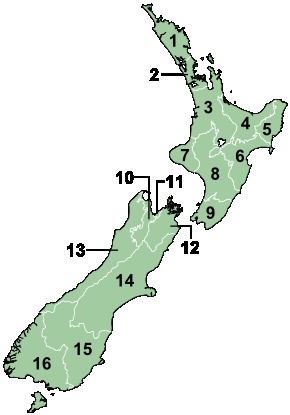Category Unitary state Number 16 | Government Local government | |
 | ||
Areas 450 km (172 sq mi) (Nelson) – 45,350 km (17,508 sq mi) (Canterbury) | ||
New Zealand is divided into sixteen regions for devolved local government. Eleven are administered by regional councils (the top tier of local government), and five are administered by unitary authorities, which are territorial authorities (the second tier of local government) that also perform the functions of regional councils. The Chatham Islands Council is similar to a unitary authority, authorised under its own legislation.
Contents
- Map of New Zealand
- History and statutory basis
- Responsibilities
- Resource management functions
- Other functions
- List of regions
- Areas outside regional boundaries
- Governance
- Auckland
- Wellington
- United councils
- References
Map of New Zealand
History and statutory basis
The regional councils are listed in Part 1 of Schedule 2 of the Local Government Act 2002, along with reference to the Gazette notices that established them in 1989. The Act requires regional councils to promote sustainable development – the social, economic, environmental and cultural well-being of their communities.
The current regions and most of their councils came into being through a local government reform in 1989 that took place under the Local Government Act 1974. The regional councils replaced the more than 700 ad hoc bodies that had been formed in the preceding century – roads boards, catchment boards, drainage boards, pest control boards, harbour boards, domain and reserve boards. In addition they took over some roles that had previously been performed by county councils. Auckland Regional Council, formed in 1989, was replaced by Auckland Council, a unitary authority, in 2010.
The boundaries of the regions are based largely on drainage basins. This anticipated the responsibilities of the Resource Management Act 1991. Most regional boundaries conform with territorial authority boundaries but there are a number of exceptions. An example is Taupo District, split between four regions, although most of its area is in the Waikato region.
Responsibilities
Regional authorities are primarily responsible for environmental management, including water, contaminant discharge and coastal management, river and lake management including flood and drainage control, regional land management; regional transport (including public transport) and harbours, biosecurity or pest management. Territorial authorities are responsible for local-level land use management (urban and rural planning); network utility services such as water, sewerage, stormwater and solid waste management; local roads; libraries; parks and reserves; and community development. Property rates (land taxes) are used to fund both regional and territorial government activities. There is often a high degree of co-operation between regional and territorial councils as they have complementary roles.
Resource management functions
Regional councils have these specific functions under the Resource Management Act 1991.
Other functions
Regional councils have responsibility for functions under other statutes;
List of regions
Notes:(1) These regions have unitary authorities. (2) The Gisborne Region is still widely but unofficially known by its former name (East Cape) or as East Coast.
Areas outside regional boundaries
Some outlying islands are not included within regional boundaries. The Chatham Islands is not in a region, although its council has some of the powers of a regional council under the Resource Management Act. The Kermadecs and the subantarctic islands are inhabited only by a small number of Department of Conservation staff, and the Conservation Minister is empowered to act as a regional council for these islands.
Governance
Regional councils are popularly elected every three years in accordance with the Local Electoral Act 2001, except for the Canterbury regional council, which is a mixture of elected councilors and government appointed commissioners. Councils may use a first past the post or single transferable vote system. The chairperson is selected by the elected council members.
Auckland
The Auckland Regional Council was preceded by the Auckland Regional Authority (ARA), which existed from 1963 to 1989.
Wellington
The Wellington Regional Council was first formed in 1980 from a merger of the Wellington Regional Planning Authority and the Wellington Regional Water Board.
United councils
In 1978, legislation was passed enabling the formation of regions with united councils. Twenty regions were designated, excluding the Auckland and Wellington areas. For most of the country this was the first regional level of government since the abolition of provinces in 1876. Councillors were not elected directly – they were appointed from the various territorial local authorities (TLAs) within the region.
The only responsibilities mandated by the legislation were coordination of civil defence and development of a regional plan, although the constituent TLAs could agree on additional responsibilities at the point of formation of each united council. For example, in a number of cases the united council took responsibility for the allocation of revenue from regional petrol taxes.
The united councils were based in the facilities of the largest TLA in the region and largely dependent on the TLAs for resources. They were allowed to levy rates but in most cases had minimal operating budgets (below $100,000 per annum). The notable exception was Canterbury, where the united council had a number of responsibilities. Only one united council undertook any direct operational activity – a forestry project in Wanganui.
Source: Summary of the Functions and Activities of United Councils. Dept of Internal Affairs, 1984.
